
I define a “high tech planted aquarium” as an aquarium with CO2 gas injection to at least 20 ppm and high intensity LED lighting with blue and crimson components (“grow lights”). In general, high tech planted aquariums have the following characteristics:
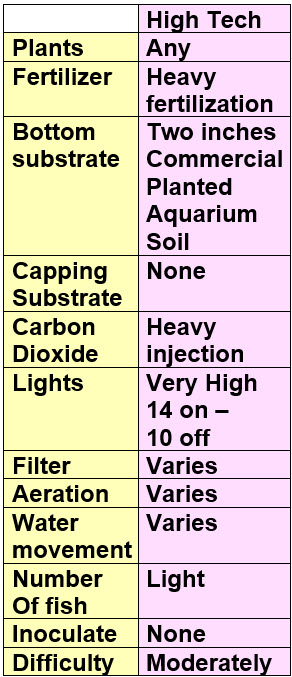
Note this is ONLY a TYPICAL set up. None of these parameters are cast in stone. They can all be changed with success.
The main downside to high tech planted aquariums is the cost. One must have a lot of equipment for the CO2 injection and the good stuff is not cheap. Expect to pay $400 to $700 for the system when all is said and done.
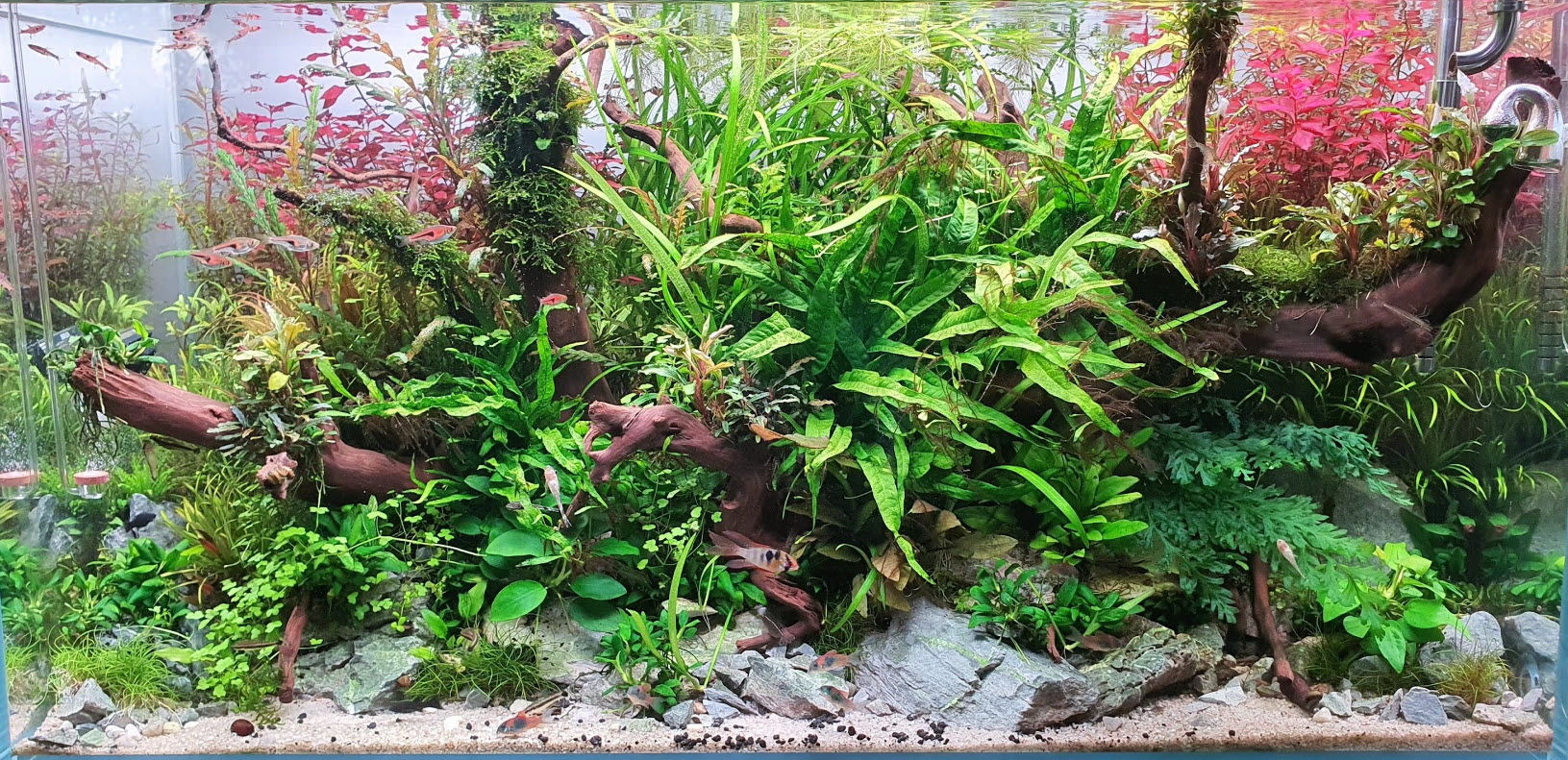
Most high tech planted aquariums have the following characteristics in more detail:
- Substrate: Expensive commercial “Aquarium Soil”
- Fertilization: Frequent and heavy
- Carbon Dioxide: CO2 injection to 25 to 40 ppm
- Lights: High powered LEDs with blue and crimson
- Filter: varies
- Aeration: None
- Water movement: Some low in tank
- Fish: Small numbers of small fish
Note that a high tech tank does not have any certain “look” to it nor does it have to have a careful aquascaping done to it. And be forewarned, there are some “aquascaping police” who think anything other than a finely manicured Dutch style aquarium is a “swamp” which is beneath their contempt. The following very beautiful “natural” tank had a very high tech CO2 system on it. But the “aquascaping police” will denigrate it.

Substrate for High Tech Aquariums
Most “high tech” planted aquarium hobbyists use expensive commercial aquarium “soils”. And they are all buying into a huge amount of marketing hype which simply isn’t true. Commercial aquarium “soils” are just high-priced marketing hype that make a lot of money for some manufacturers.
Most commercial “hard” aquarium “soils” are calcined clays or ground weathered lava rock. The term “calcined” means clay which has been heated to around 1,300 degrees F. and literally fused into a hard ceramic product. This calcination process basically turns clay into rock.
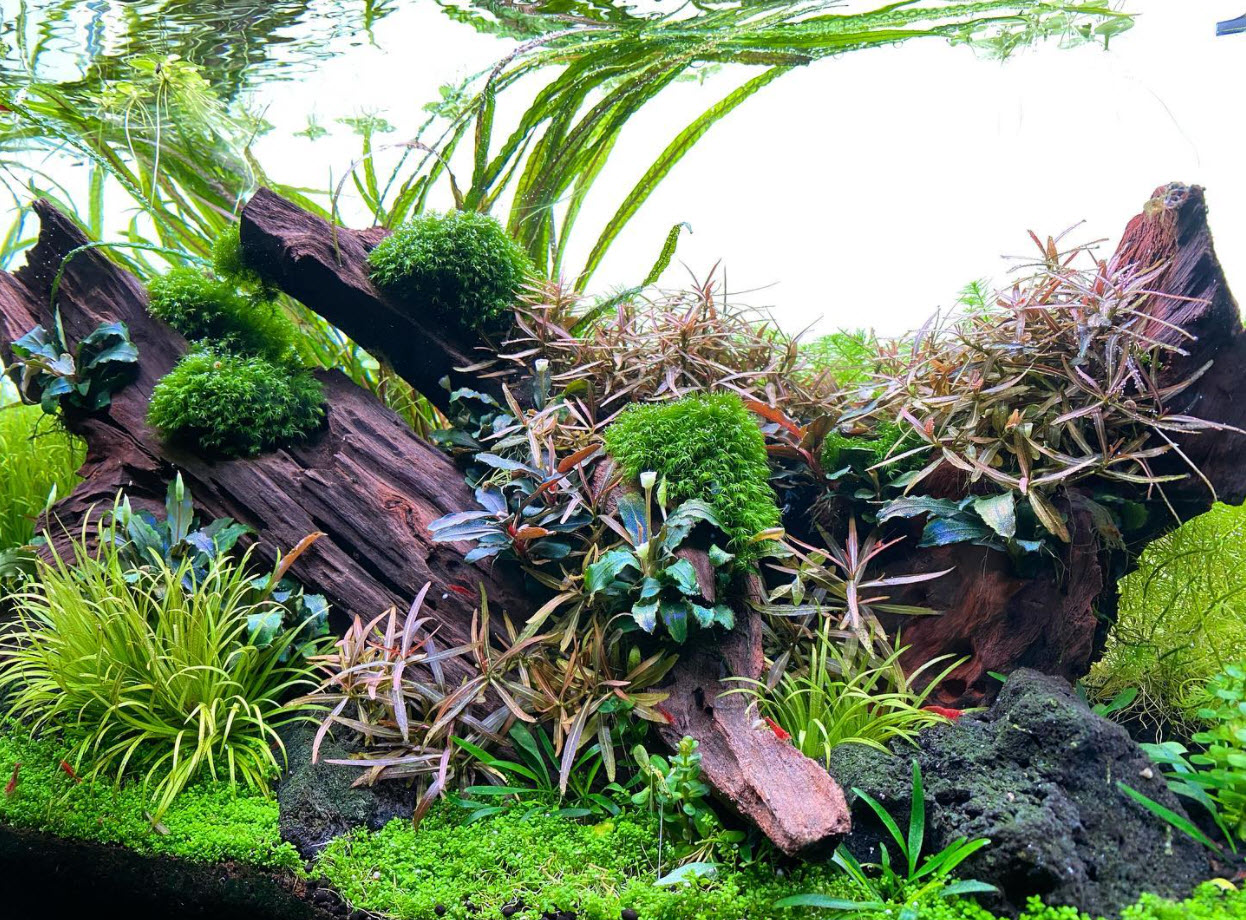
These hard “soils” do not have organic matter or fertilizer in them. Contrary to their marketing hype, these “soils” are NOT fertile and do NOT have “high cation exchange” capacity. These high-priced “soils” do NOT store nutrients well. But many have beautiful planted “high tech” tanks using these commercial calcined “soils”. If these hobbyists had used good old aquarium gravel they would have had the same results at a lot lower cost.
There is a second type of “soil” which is softer, lighter in weight and tends to decompose. This product apparently has some fertilizer in it. These “aquarium soils” typically last about one year before becoming mud. These appear to be “baked” clay products (i.e. clay heated to about 300 degrees F with a binder). These products are very expensive and simply not worth the money.
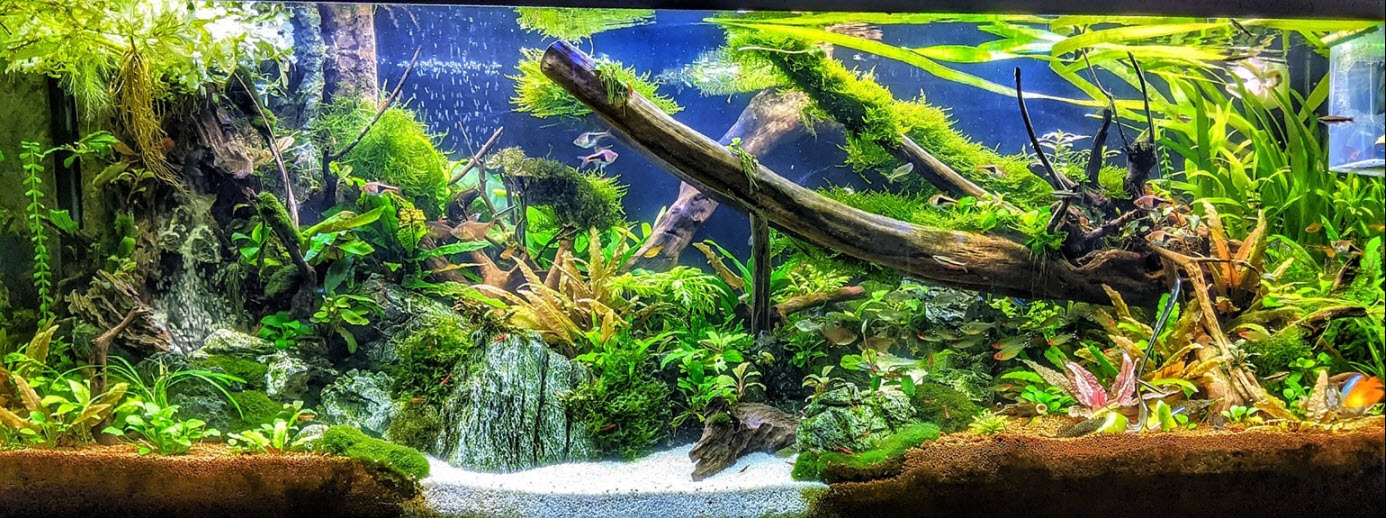
In truth any substrate will work well in a “high tech” (CO2 injected, high fertilization, high light) planted aquarium. The substrate just isn’t anywhere near as important as all the marketing hype suggests it is. Indeed, many experienced hobbyists say that a “dirted” tank is the best way to go with high tech tanks. By “dirted” we mean one inch of cheap organic garden soil covered by one inch of sand or gravel.
More on substrates can be found at this link:
15.7. Substrates for Planted Aquariums
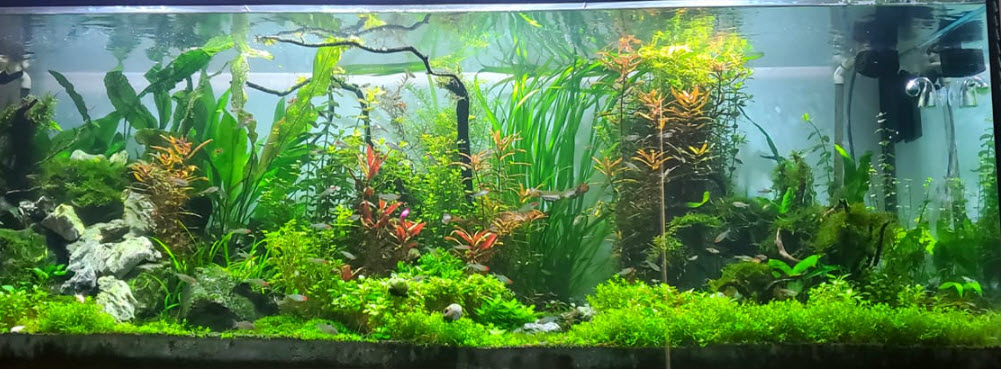
Fertilization
There are about as many fertilization schemes as there are keepers of high-tech planted aquariums. We go into that in great depth in this link:
15.5. Fertilizing
Carbon Dioxide
One key feature of all high-tech planted tanks that allows them to become the lush gardens they are is carbon dioxide injection.
15.6. Carbon Dioxide
Carbon dioxide levels are VERY important in high tech aquariums. The aquarium below was where the operator ran out of CO2 and just let the tank go for a while with no CO2. The result was stopping of active growth by the plants and the start of a huge algae outbreak.
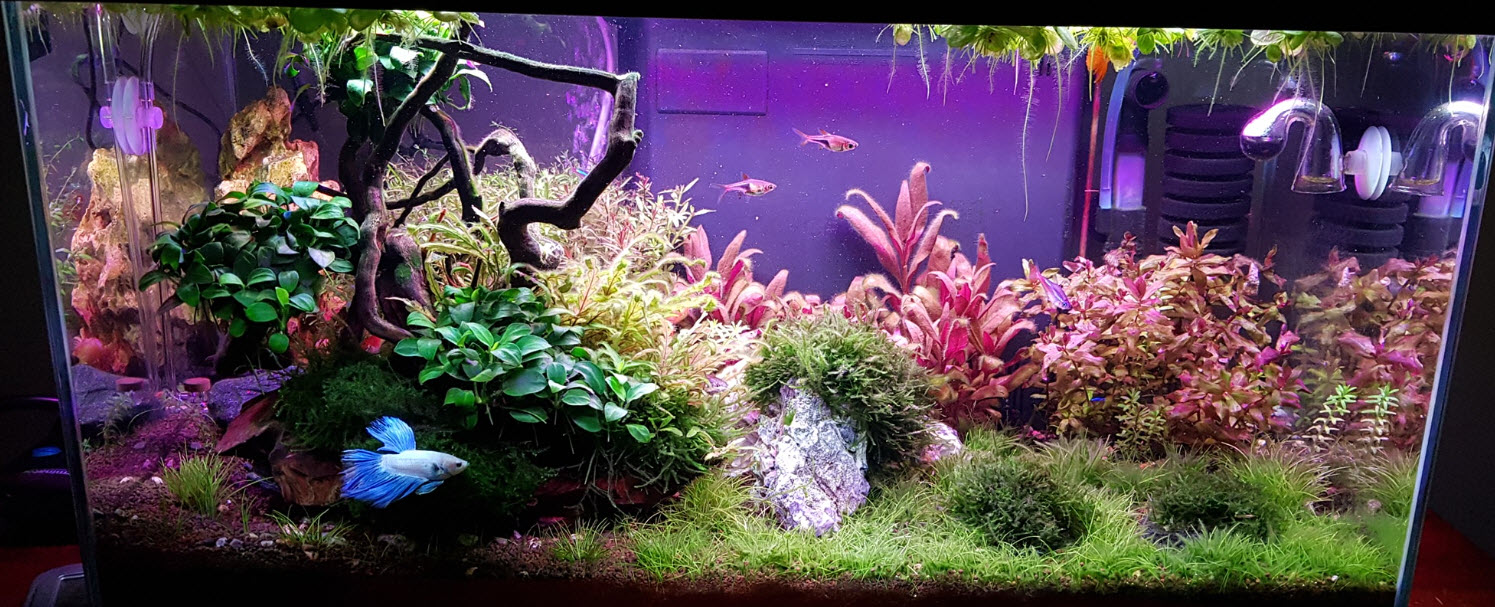
Note the deep blue color in the drop checker. And the coating of green algae on SOME of the plants. The hobbyist tore the tank down. This was unfortunate as if the CO2 level had simply been taken above 20 ppm the plants would have resumed growth and killed the algae.
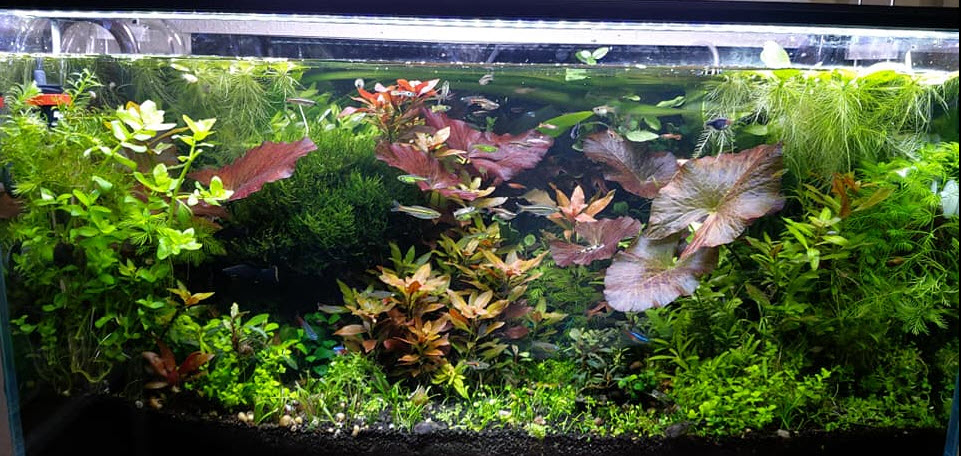
Lighting
The lighting for high tech planted tanks needs to be very intense. It also needs close control of the spectrum of the lights. Plants need blue and crimson lights (i.e. violet “grow lights”) while they are growing. But the human eye likes a different spectrum. So planted aquariums typically have two lighting “schedules”. One type of lighting while the plants are in view, and one type of lighting when the plants are not being viewed.
More about this at this link:
14.4. Lights for the Aquarium
Fish for a High-tech Planted Aquarium
Like most planted tanks, high-tech planted tanks utilize small schools of small fish. Some have shrimp in them. More about this at this link:
15.2. Fish for Planted Tank
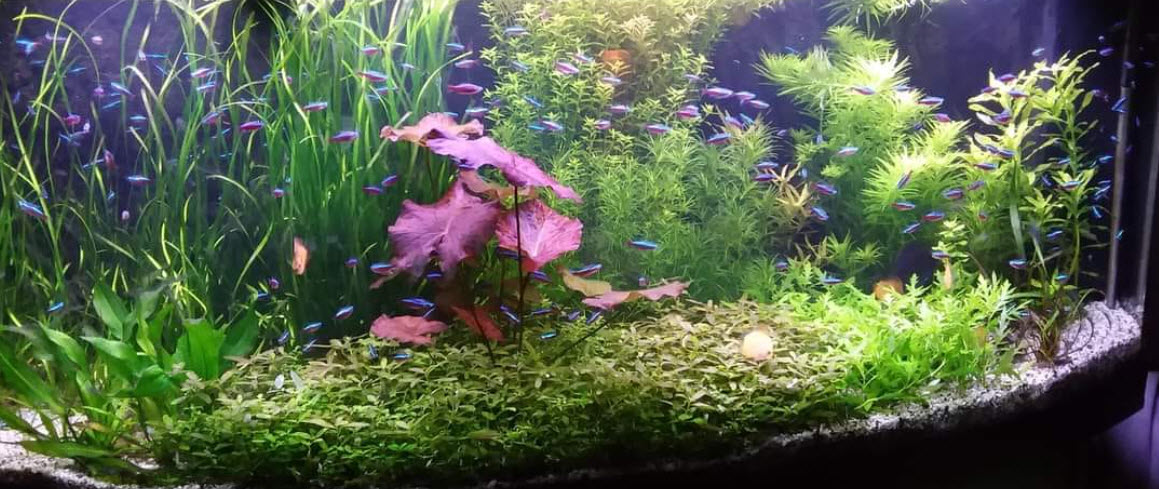
CO2 and Aeration
Most high tech tanks I’ve seen have very little aeration in order to conserve the CO2 in the aquarium. But a few use high aeration. The amount of CO2 being put into the tank, the amount of aeration and the time to get up to a decent level of CO2 is a very complex relationship. A fifty gallon tank with fish might get to various CO2 levels under several different scenarios:
- rapid injection of lots of CO2 and large amounts of aeration might only take 30 minutes to get to 30 ppm and it will safely hold the 30 ppm for the rest of the day
- rapid injection of lots of CO2 and no aeration might only take 40 minutes to get to 40 ppm and kill the fish in the tank
- three bubbles per second of CO2 and moderate aeration might take two hours to get to 30 ppm and it will safely hold the 30 ppm for the rest of the day.
- One bubble per second and no aeration might take six hours to get to 30 ppm and it will safely hold the 30 ppm for the rest of the day.
- One bubble per second and large amounts of aeration might take ten hours to get to 12 ppm and it will safely hold the 12 ppm for the rest of the day.
Most planted tank enthusiasts do not have significant numbers of decent sized fish in their tanks and low aeration. The air stone, air pumps and wavemakers can be removed from aquariums with only small schools of small fish in them. In low stocked aquariums one can safely go as high as 30 ppm CO2. Some, including the guru of planted tanks, Dr. Tom Barr, go to 40 ppm CO2.
More information on setting up a high tech CO2 injection system can be found at this link:
15.6.3. High Tech CO2 System
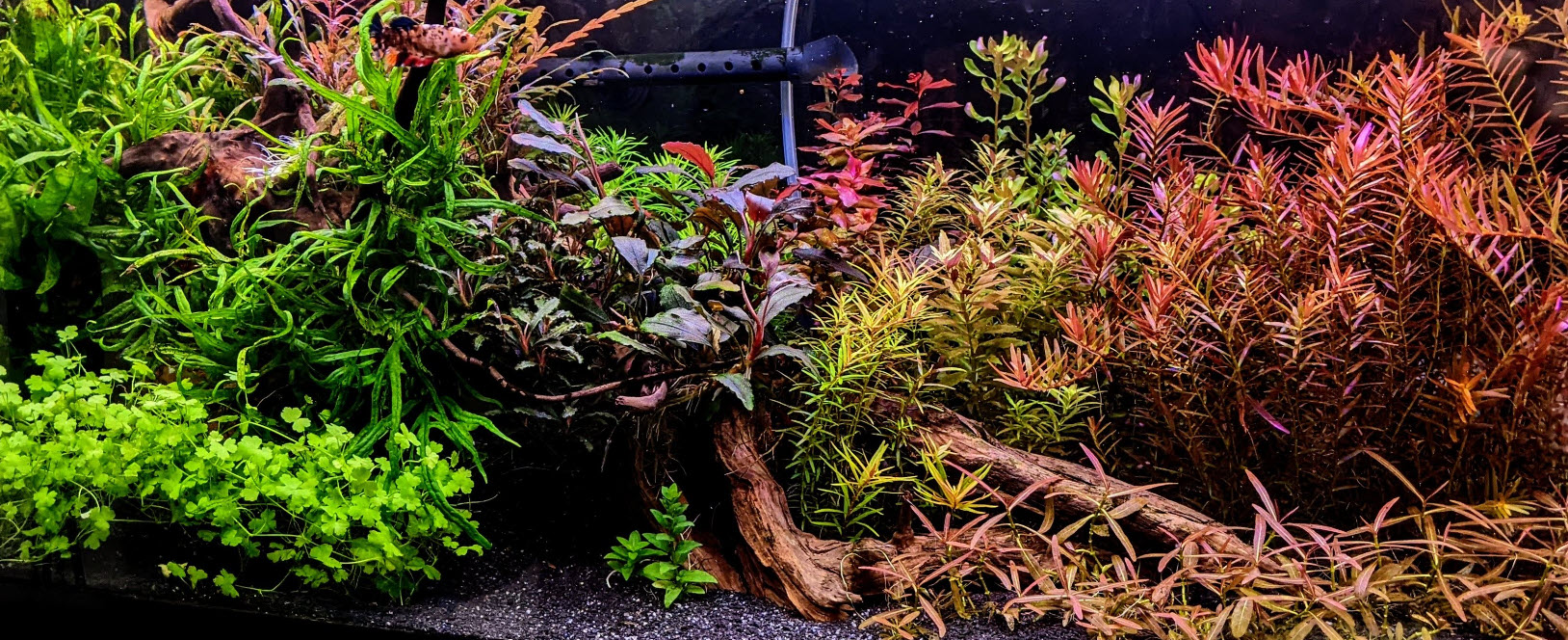
Filtration for a High Tech Aquarium
The trick with filtration in most high tech aquariums is to add the filtration in such a way that the outlet of the filter is deep in the aquarium and moves the water slowly down or across, never up. This is to keep aeration low. Diffuse and slow the water flow via oversized caps. As the stocking of fish increases the need for filtration increases and it becomes more and more difficult to hold a high CO2 level.
There are a whole series of small DIY filter designs that will work very well with this type aquarium (very low fish stocking) and can be seen at the following article:
8.7.8. DIY Filters

Planted Aquariums in Depth
The following sections will tell you how to make a planted aquarium:
15. Planted Aquariums
15.1. Planted Aquariums in Depth
15.2. Fish for Planted Tank
15.3. Fish Limitations
15.4. Types of Planted Aquariums
15.8. Walstad Aquarium
15.10. Hybrid Planted Aquariums
15.11. Many Fish Many Plants
Here is another “natural” high tech aquarium

.
Return to Home Page and Main Menu
.
Aquarium Science Website
The chapters shown below or on the right side in maroon lead to close to 400 articles on all aspects of keeping a freshwater aquarium. These articles have NO links to profit making sites and are thus unbiased in their recommendations, unlike all the for-profit sites you will find with Google. Bookmark and browse!
.

Dave says
In reply to David ……. I’m finding that a sump with 20% Chinese “Macro” foam and 80% K1 media to filter out small particles that seem to be resistant to filtration by K1 alone (at a reasonable price)’
O2 injection at night and CO2 injection during the daytime will allow reasonable fish stocking.
I avoid CO2 injection with discus. One regulator failure will cost a mint in dead fish.
David Kennedy says
I am doing a high-tech 120g planted tank with a sump. What filter medium would you recommend for this setup?
100% Fluidized K1: aeration would cut into CO2, (could put timers to aerate only when lights are off to maximize filtration while minimizing CO2 loss)
100% K1, no air stones.
100% Poret Foam: I haven’t run the cost but I believe this would be really expensive.
Mix of Poret Foam and K1: You mentioned that mixing media types doesn’t make sense. if K1 is the most efficient, wouldn’t we want to just use K1? what is the advantage of using Poret?
Does aeration while injecting C02 make any sense? I think adding C02 would create O2 loss and vice versa. Hence the timers.
Can you or would you recommend keeping Discus in a high-tech tank? (Future tank idea)
Love your content! It is by far the best aquarium content (or content in general) I have come across.
Thank you,
David